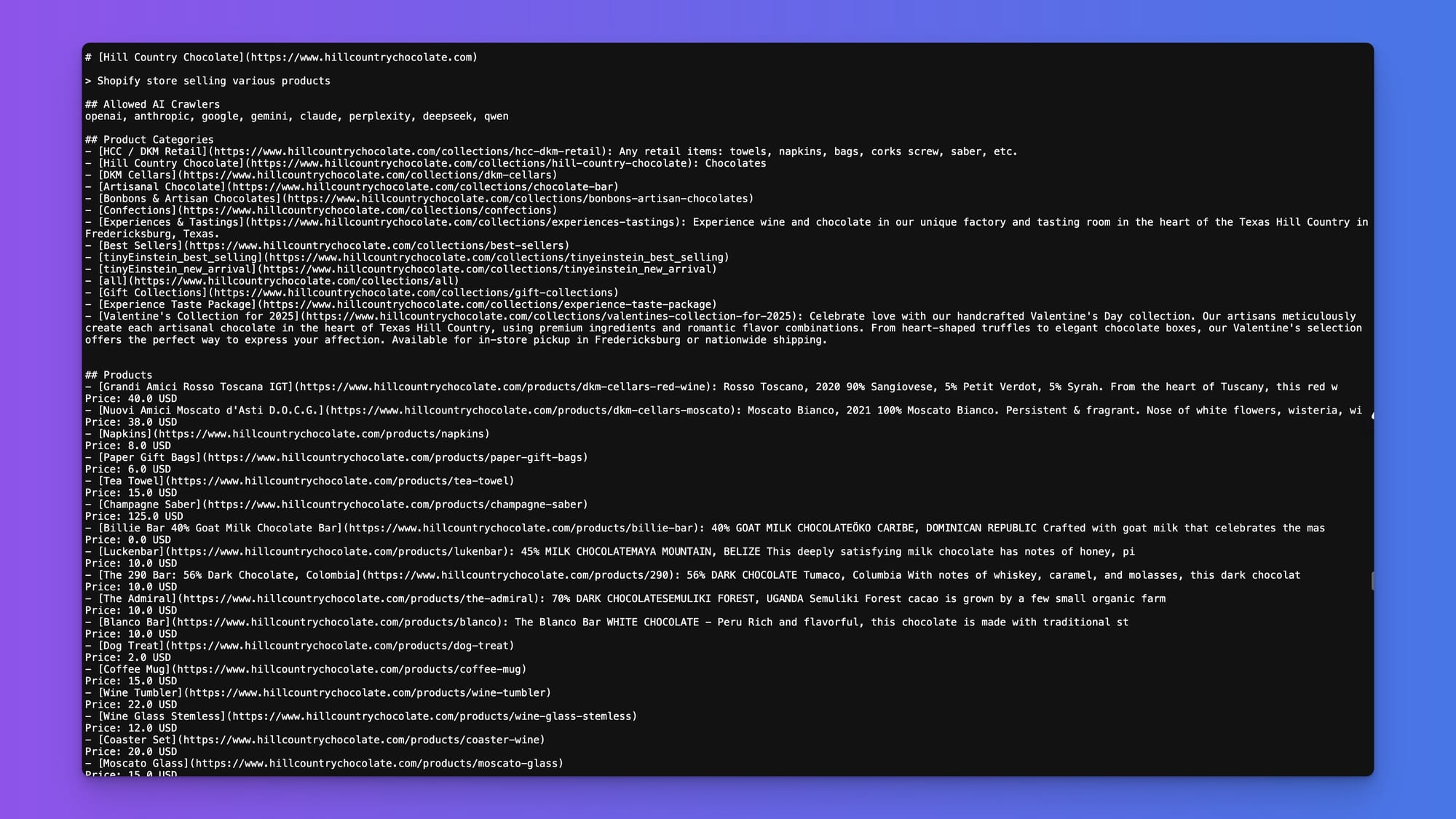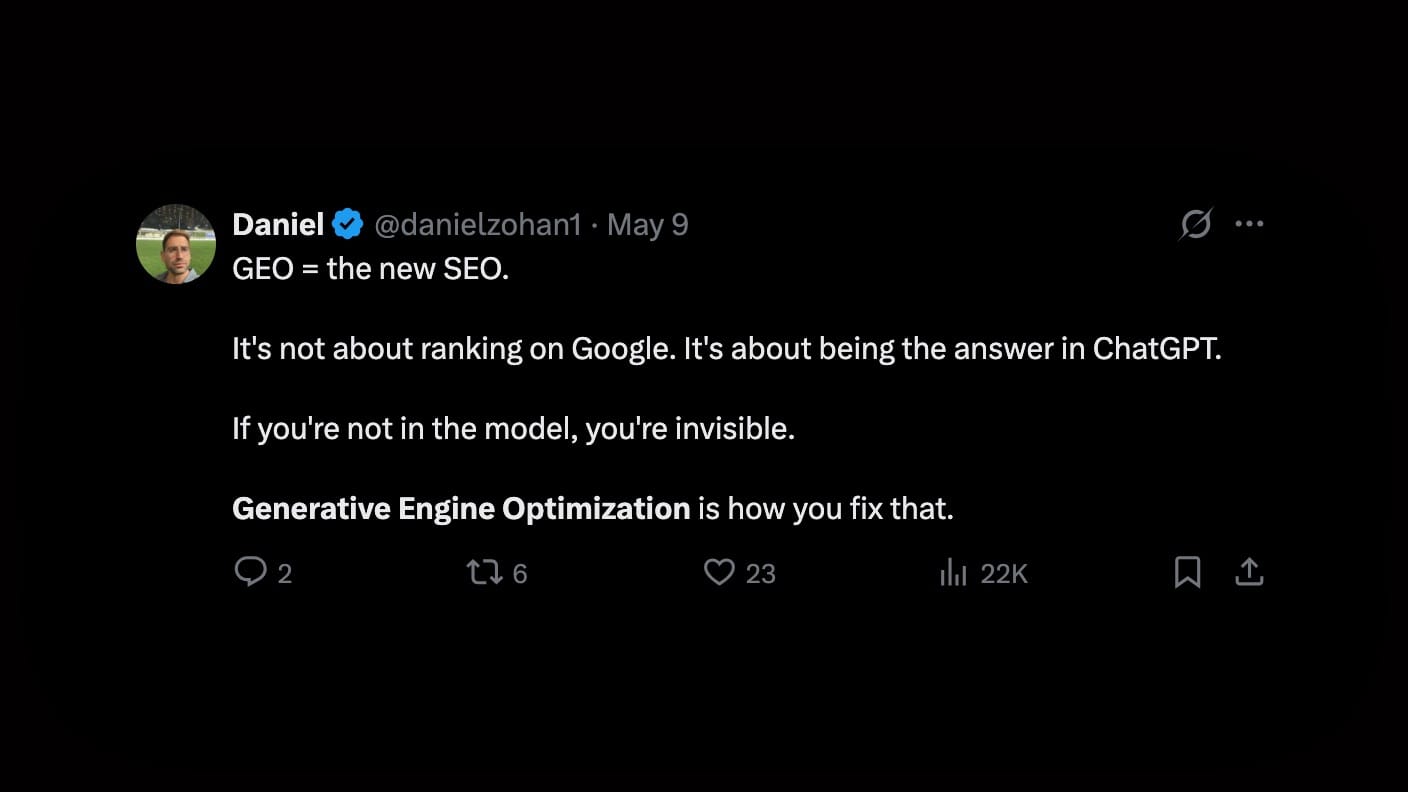Beyond PageRank: Why Your Business Needs a Generative Search Strategy

This past weekend, I had the opportunity to sit on a panel at the Texas Medical Association convention in San Antonio focused on social media and ethics.
While I expected questions about maintaining professional boundaries or managing online reputation, one question caught me by surprise: "How does search engine optimization for medical practices relate to social media, especially in this new AI environment?"
The question revealed a growing awareness that something fundamental has shifted in how people find businesses online.
It wasn't just about Google rankings anymore—it was about how practices appear in AI-generated responses when potential patients ask questions.
This isn't just relevant for physicians.
The first time I heard someone mention they found our chocolate factory because ChatGPT recommended it as a "must-visit experience in Fredericksburg," I realized we'd crossed a digital Rubicon.
This wasn't another technology trend—it represented a fundamental shift in how people discover and evaluate businesses of all kinds.
Let me be clear: traditional SEO isn't dead. But relying solely on conventional search optimization is now like insisting on film photography in a digital world—technically valid but strategically limiting.
From Indexed Pages to Synthesized Answers
The question isn't whether generative AI will transform search—it's already happening.
When someone asks Claude or ChatGPT about providers, experiences, or services in their area, they receive a synthesized answer, not a list of links to evaluate.
This fundamental difference requires a new optimization approach. I've spent the past year testing various strategies across my businesses, measuring what actually gets meaningful results in generative search visibility.
The data points to three high-leverage opportunities that don't require massive resources but do demand a shift in thinking.
The Surprising Resurrection of Press Releases
Ten years ago, press releases were primarily reputation management tools. Five years ago in digital marketing, they became largely dismissed as link-building relics.
Today, they've gained new strategic relevance—not for the backlinks, but for their distribution footprint.
When our chocolate company launched a new line of roasted pecans, we issued a structured press release through a RocketTools distribution network. The content appeared on over 600 websites.
More importantly, when prompting AI systems with questions about crispy pecans several months later, our release information frequently appeared in responses—despite our relatively small market position.
This isn't coincidental.
AI training processes prioritize information that appears consistently across multiple domains. A well-structured press release creates dozens of identical high-quality references to your business, products, and expertise.
The key difference between effective and ineffective releases lies in their composition:
- Focus on clear, factual statements about your business
- Include specific, unique details that differentiate your offering
- Structure information hierarchically with the most important elements first
- Minimize marketing language in favor of concrete descriptions
And, most importantly, if possibly connect your content to something truly newsworthy.
Information presented as objective fact rather than persuasive argument typically travels further through AI systems. Plus, it will help your press release gain widespread distribution.
These systems more confidently reference clear statements of fact than marketing claims.
The Technical Edge: Making Content AI-Readable
Your digital business content serves multiple audiences: potential customers, current clients, search engines, and, increasingly, AI systems.
While conventional websites balance design, user experience, and SEO considerations, they aren't optimized for AI comprehension.
This is where the emerging llms.text files approach offers a technical advantage.
Similar to how robots.txt guides traditional web crawlers, an llms.txt file provides AI-friendly versions of your content in structured markdown format.
I implemented this for both my consulting practice and chocolate business using a straightforward approach:
- Creating comprehensive markdown documents with factual business information
- Organizing content with clear hierarchical headings
- Including specific product, service, and expertise details
- Placing these files at standardized locations on our domains
For our chocolate company, we even leveraged our widely read blog in the text file.

While not yet an official standard, this approach aligns with how AI companies like Anthropic and Perplexity are beginning to think about structured content ingestion.
Implementing it now positions your business advantageously as these standards formalize.
And it is really easy and doesn't hurt your SEO strategy or your site speed.
When testing identical prompts across multiple AI systems, businesses with structured markdown implementations consistently received more accurate and complete representation than those without.
Again, this is just our testing. Time will tell if this approach is helpful.
AI systems today are good at scraping modern websites, but this falls into the category of "make things easy" for AI and you will be rewarded.
The technical implementation isn't complex—most developers can add these files in hours rather than days. For our Shopify store at hillcountrychocolate.com this took less than 15 minutes.
The strategic work lies in determining what information to prioritize and how to structure it for maximum clarity.
Platforms Matter: The Influence Hierarchy in AI Training
Not all online platforms carry equal weight in AI training data. Through our anecdotal testing, we've identified that content from certain platforms has a disproportionate influence on how businesses appear in generative search results.
X (formerly Twitter) and Reddit show particularly strong influence patterns. This makes sense considering their text-dense nature and focus on timely, expert discussions—precisely the attributes that make for valuable training data.
We've been encouraging clients for the last year to re-engage on X.com.

I'll admit the platform went through some stale times before the X-conversion, but today it has become much more robust and active. For businesses, posting on X is somewhat "safer" than Reddit, which requires a more concentrated approach to sharing content.
The strategic implication is clear: targeted content on high-influence platforms delivers outsized returns on investment for generative search visibility.
This isn't about social media marketing as typically practiced. The metrics that matter aren't likes or shares, but the creation of substantial expertise-demonstrating content that AI systems can confidently reference.
Measurement in Uncharted Territory
The challenge with generative search lies in developing meaningful metrics for this emerging channel.
In our testing, we've found success with a three-part measurement framework:
- Representation Accuracy: Regularly prompting multiple AI systems with relevant queries and scoring how accurately they represent your business
- Inclusion Rate: Tracking the percentage of topic-relevant prompts that result in mention of your business
- Attribution Tracing: Asking new customers how they discovered you and specifically tracking AI-assisted discovery
It is important to test your query request on multiple platforms. Today, ChatGPT is the clear dominant player, but don't skip out on Perplexity or even Google Gemini as these platforms are growing in popularity among consumers.
This approach isn't perfect, but it provides actionable data during this transitional period. As the channel matures, more sophisticated measurement tools will emerge.
The parallels to early SEO measurement are striking.
Those who developed even imperfect measurement systems in the early days of search optimization gained significant advantages as the field matured. Don't miss out on the same phenomenon in generative search.
Implementation: An Iterative Approach to New Territory
We often must act on incomplete information in business.
When a new channel emerges, leaders balance early adoption against the limitations of preliminary evidence.
Generative search optimization presents a similar challenge. The complete playbook doesn't exist yet, but waiting for perfect clarity means missing the early-adopter advantage.
My recommendation is a measured, iterative approach:
- Start with structured press releases for major company developments
- Implement basic llms.textfiles on your primary domains
- Develop a focused strategy for one high-influence platform (X or Reddit)
- Establish baseline measurements using the framework outlined above
- Iterate based on observed results over 3-6 month intervals
This balanced approach captures the advantages of early positioning without over-committing resources to unproven tactics.
If you want a more detailed implementation strategy, checkout this blog post by Charlie Marchant from Exposure Ninja.
The Future of Digital Visibility
The most valuable real estate in business has always been the space between your offering and your customer's awareness.
For decades, that space was primarily mediated by traditional advertising, then by search engines. Now, it's increasingly shaped by generative AI systems that don't just index information but synthesize and interpret it.
The businesses that adapt quickly will establish positions that become increasingly difficult to displace as the technology matures.
Those that wait for perfect clarity will find themselves playing catch-up in a game where early positioning creates compound advantages.
What I shared with the physician who asked that unexpected question at the TEXMED convention was simple: the rules are being rewritten, but the fundamental principles of valuable information and strategic distribution remain.
The winners won't be those with the biggest budgets, but those who recognize this shift early and adapt most intelligently.
The opportunity today isn't just optimizing for algorithms—it's reshaping how your business appears in the artificial minds increasingly responsible for guiding human decisions.
That's not just a technical challenge; it's a strategic imperative that will separate the visible from the invisible in the next generation of digital discovery.

Member discussion